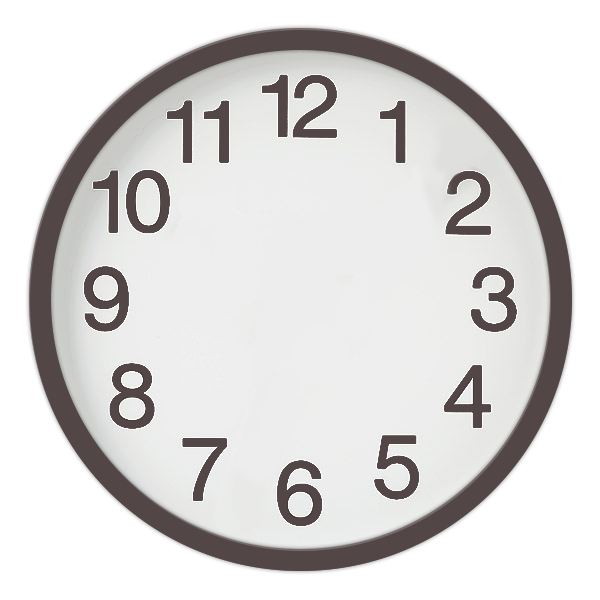Coming Soon...
OKSomething went wrong!
Please try again later.

The connection between the hands and clubhead is critically important. After all, it’s your only true linkage to the golf ball, meaning any slippage or loss of traction can lead to devastating shot results. And that’s no matter how well you swing it!

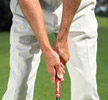 |
So, check your grips routinely for wear and tear, and/or any loss of tackiness. Furthermore, make sure your grips are fitted properly for both your hands and your golf swing. Typically, smaller grips are better for smaller hands, but they also aid in helping the hands rotate through the shot. Fatter grips have the opposite effect, and can actually lessen the rotation of the hands to prevent excessive hooking of the ball. Experiment with different sizes and see what works best for you.
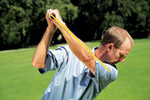 |
NEUTRALIZE YOUR GRIP PRESSURE
YOU MAY KNOW THE CORRECT HAND POSITION, but how many times have you considered how tight or soft you should grip the club? In reality, it depends on both your natural grip strength and how well you set the hands at the top of your golf swing.
| Too tight | Too soft |
To get a better hold of how firmly you should grip the club, first examine how well your hands are functioning at the top of the swing. In the photo above, you can see that the back of my left hand is flat, the clubshaft is on plane (it’s hidden behind my hands), and my wrists are fully hinged. Now, if I grip the club too firmly, my wrists won’t hinge enough, meaning I’m likely to release the hands too soon through the downswing.
If I grip the club too softly, not only am I likely to regrip and lose the proper club position, but my swing plane is going to suffer, since the shaft is likely to droop behind or in front of my hands.
USE YOUR LIES TO YOUR ADVANTAGE
No! |
The intermediate cut of rough can actually be an easier place from which to hit a longer iron.
SWING DOWN THE FIRST CUT
 |
A GREAT WAY TO check the direction of your swing path is to take a few practice swings along the first cut of rough. With the clubhead positioned just inside the first cut (the toe barely touching the rough), you’ll be able to quickly see whether or not you’re swinging down the line, too much inside-out, or as the small photo above shows, too much outside-in. You can even use a tee to get a better idea of where you want to make impact with the turf.
Another great swing thought to have is to try to swing the club parallel to the line midway through the backswing, and again, parallel through the line midway through the downswing. You can see here, I’m almost perfectly parallel on the downswing, the toe of the club is pointing up, and my body is rotated through. I’ve definitely swung straight down the line here.
THE SHADOW CHECK
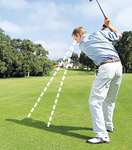 |
OUT ON THE COURSE, YOU PROBABLY WON'T FIND TOO MANY FULL-LENGTH MIRRORS, but that doesn’t mean you can’t check your swing to see whether you’re swaying or not. To do so, simply turn your back to the sun so your shadow is in front of you. Start at the setup and note where your head and hips are. As you swing back, watch your shadow and make sure you’re rotating, not sliding back and forth. This also is a great way to make sure you’re keeping your spine angle, too.
Once you’ve practiced with the shadow, turn around, face the sun and repeat the way a good swing feels. This will train your mind to ignore your shadow and keep you focused on the back of the ball come time to hit your next shot.
 |
Give it a try, use your shadow and make sure you rotate, not slide, through the hit.
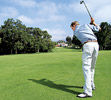 |
At the setup, your shadow should resemble a golfer with no arms. Pay attention to any tilt away from the target, as well.
The shadow you cast when you slide too far away from the ball will show you a lot of things: a slide, a greater separation of the hands and a clubshaft that’s not parallel to the target line.
TWO-TEE DRILL
 |
 |
 |
| 1 | 2 | 3 |
What’s the secret behind solid ballstriking? Ball-first contact! Hitting the ball first, before you make contact with the turf is critical if you want to become a better ballstriker.
A great way to practice ball-first contact (without actually using a ball) is to use two tees, situated gate-style in the position where your golf ball would be. As you swing, concentrate on hitting the turf on the target side of the tees, and not behind. Notice in the sequence above, doing so requires two key components. The first is a good extension of the arms. The second is a full rotation of the body through and up to the finish.
| Iron Types Choosing the right type of irons for your game ought to be your first step toward improving your score. And if a new set isn’t in the budget, or you’re content with what you have, at the very least, consider getting your irons properly fitted. This means having them inspected for length, loft, shaft flex and lie angle. You may find that your irons fit improperly, and a few tweaks will make a big difference in helping you hit better iron shots. Or, let’s say your irons actually fit your game as they should. Then why aren’t you seeing any improvements? The answer may be in the type of iron set you have. If you struggle with a lack of distance, wayward shots or even getting the ball airborne, maybe it’s time to ditch those blade-style irons and opt for a cavity-back set—or better, a mixed set with a couple hybrid irons to choose from. Either way, the era of sizing up one’s golf game based on the types of equipment in the bag are long gone. Many of the best players in the world not only have adopted cavity-back styles, but also have worked hybrids into their sets. This is all in an effort to stay competitive and hit shots that, frankly, you could never do with a long-iron blade. |
FEET-TOGETHER DRILL
 IF YOU HAVE TOO MUCH UPPER-BODY ROTATION, a great way to check is to try the feet-together drill.
IF YOU HAVE TOO MUCH UPPER-BODY ROTATION, a great way to check is to try the feet-together drill.
Too much upper-body rotation is usually the culprit behind bad balance and bad positions at impact. To check yours, stand with your feel together and make a few swings at full speed. If you’re falling over in any direction, you probably have more upper-body rotation than your lower body can handle. The solution? Either scale back your backswing or add more middle-body rotation to the mix. This will help stabilize your motion and, in turn, lead to better balance and more consistent ballstriking.
STEP-INTO-IT DRILL
PROBABLY THE TOUGHEST aspect OF THE GOLF SWING is understanding how to make a solid transition from backswing to forwardswing. In reality, there ought to be three things working together. First, the weight shifts to the forward side. Second, the body rotates. And third, the hands drop and release over the ball. Seems simple enough right? Not quite. Understanding the order of these motions is the toughest part.
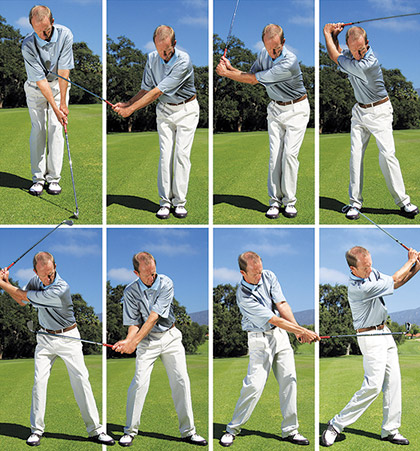 |
To better train your body to follow a proper sequence, consider this drill. First, start in your setup position, and then move your forward foot (my left in the first photo) along your right foot. Then, initiate your backswing as you normally would. Once you reach the top of your backswing, lift your forward foot (again, my left in the photos) and plant it back into the position in which it would normally be. As you do this, you’ll sense a greater feeling of the body wanting to turn toward the target and the hands coming down over the golf ball.
By “stepping into it,” you’ll get a better feeling for making a proper weight shift. The rest of the swing ought to fall into sequence naturally.
| Iron Shafts Driver shafts tend to garner the lion’s share of attention when it comes to club shafts, but don’t forget about the ol’ iron shafts in the bag. What you don’t know might actually be hurting your game. To become better-informed, first make sure your iron shafts are cut to the right length and have a flex suited not only to your overall ability, but also to your tendencies with each type of iron. For instance, maybe you prefer making short, aggressive swings with your short irons, meaning, stiff shafts will work better in the higher-lofted irons. Or, perhaps you prefer swinging easier with your long irons, thus requiring a softer flex profile in the long irons. Either way, a set can be dynamically arranged so each iron flexes exactly as you’d like. Go to a fitter and see what we mean. |
TEE-FLIP DRILL
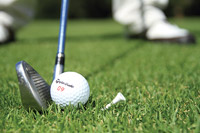 |
HOW MUCH OF A DESCENDING BLOW YOU NEED? Now that you know you need to clip the ball first before you make contact with the ground, how steep should you be?
A great way to practice the perfect descending blow into the ball is to try to mimic my position in the photo to the right. See how my hands are just ahead of the ball, my hips have rotated, and my head is slightly back? This is the position you want at impact, but getting here is going to require some practice.
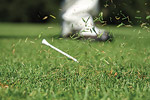 |
To get started, try the tee-flip drill. Take a tee, and place it in front of the ball (toward the target). Push it into the ground so it’s snug and doesn’t pop out too easily.
From this position, make a swing! If you execute the proper downswing, you should not only hit the tee, but also be able to pop the tee out of the ground.
Practice this drill anytime you feel as though you’re hitting it too fat or too thin. You’ll quickly be on your way toward making crisper contact.
SETUP VS. IMPACT
 |
The reality is, there’s actually a big difference between the setup and impact position. At impact, the weight is on the forward side (target side), the hips and lower body are open, and the shaft is leaning forward.
WALL CHECK
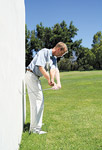 |
MAKING A GOOD BACKSWING DOES NOT HAVE TO BE DIFFICULT. A simple way to check and see if you’re taking the club back straight along the target line is to check with a wall behind you.
The goal is to make a ¾ backswing and a ¾ followthrough. (Eventually the club will hit the wall, even with a good swing. So, stop
the downswing ¾ of the way through the forwardswing.) If you take the club back too far inside, you’ll hit the wall on the backswing. If you do the opposite and take the club back too far outside, you’ll likely come over the top and hit the wall through the downswing.
As a bonus, this is a great tip to ensure you retain the needed spine tilt toward the ball.
| Lies, Lies, Lies! If your irons don't fit, there are some surefire hints as to why that might be. For instance, if you struggle with shots that fly too far to the right, your irons may be too flat for your swing. If you tend to hit most of your irons to the left, they might be too upright for your natural ability. Bending the lie angle of your irons is a simple fix to help you hit straighter shots in no time. |
DIAL DOWN
 |
UNLIKE WITH THE DRIVER OR EVEN SOME OF YOUR FAIRWAY WOODS, you don’t necessarily want to hit every shot with your irons as far as you possibly could. In a given round, you’re probably just as likely to have as many in-between distances as you will distances that set up well for a particular iron in your bag.
A great way to practice and to get a feel for different distances is to practice hitting each iron in your bag three different distances. Start with three balls, and with your first shot, hit with your average swing speed, which should be somewhere around 80 percent full power. Then, with the second ball, dial it back to 70 percent and monitor the difference. Then, with the last ball, take a swing at 100 percent and, again, track the difference in distance.
Once you get a better idea of how far you can hit a single iron at three different swing speeds, you’ll likely see that some of your distances overlap from iron to iron, which essentially fills any distance holes in your set.
Also, becoming more versatile with each iron, you’ll get a better sense of what type of shot a particular hole requires, especially in relation to trajectory and spin (typically the faster you swing, the higher the launch and greater the spin).
Do this for every iron in your bag and take the guesswork out of choosing the right club once and for all.
MAKE SOLID CONTACT
 |
DON'T GO OVER THE TOP. Speaking of swinging over the top (as the wall-check drill alluded to), an outside-in swing path is one of the worst and, sadly, more common mistakes amateurs make. It not only produces a weak and inconsistent shot, but also causes slices and duck hooks, both of which we all could do without. The opposite problem is a swing that’s too inside-to-outside the target line, which causes pushes, hooks and even the likely shanked shot. That’s just as bad.
To make sure you swing more squarely, try hitting a few shots with something along the outside of the golf ball. In my case, I have an OB stake, but I suggest you try using something softer, like a headcover. Set it as close to the ball as you can without touching it at address. The goal, obviously, is to avoid contact with your headcover through the entire swing. If you’re too outside-to-inside, you’ll hit it. If you’re too inside-to-outside, you’ll still hit it. The right amount is to swing inside-to-inside the target line, straight toward the target. Practice this often and you’ll hit straighter shots.
FINISH STRONG ON YOUR FORWARD LEG
 |
JUST BECAUSE IT'S NOT YOUR DRIVER, that’s not enough of an excuse to quit on your swing and not make a solid rotation. For even the most delicate of shots, whether it be a 100-yard pitch or an easy 7-iron, you always want to finish on your forward leg. If you don’t, you run the risk of not making a full rotation, releasing the club too soon, and, well, you can guess what types of shots will ensue.
As you practice, work on finishing on your forward leg, even with shorter-iron shots, punch shots, 3⁄4 shots or what have you. In this photo, I’m hitting an easy 6-iron. Even though my finish is abbreviated, my weight shift is anything but. I’m fully rotated, and my weight is solidly placed over my left leg.
Some of the best players in the world have said they don’t think about anything in the golf shot other than how they finish. Give that a try and, no doubt, you too will see how a finish-focused swing will help the rest of your motions fall in sequence automatically.
4moles Editorial | April 22, 2024
The energy was electric at THE ALMA MATER CUP - Alumni Invitational 2024, a dynamic golf event managed by 4moles.com at Qutab Golf Course on April 19, 2024. Over 120+ alumni from seven renowned NCR sch Read More
PGA | April 15, 2024
Scottie Scheffler entered the final day of The Masters with a one-shot lead, maintaining his position at the top throughout a tense Sunday. Despite several players threatening his lead, Read More
Ladies European Tour | April 24, 2024
Indian golfer Diksha Dagar made a significant climb to the 11th spot on the LET Order of Merit following her outstanding performance at the Joburg Ladies Open. Read More





